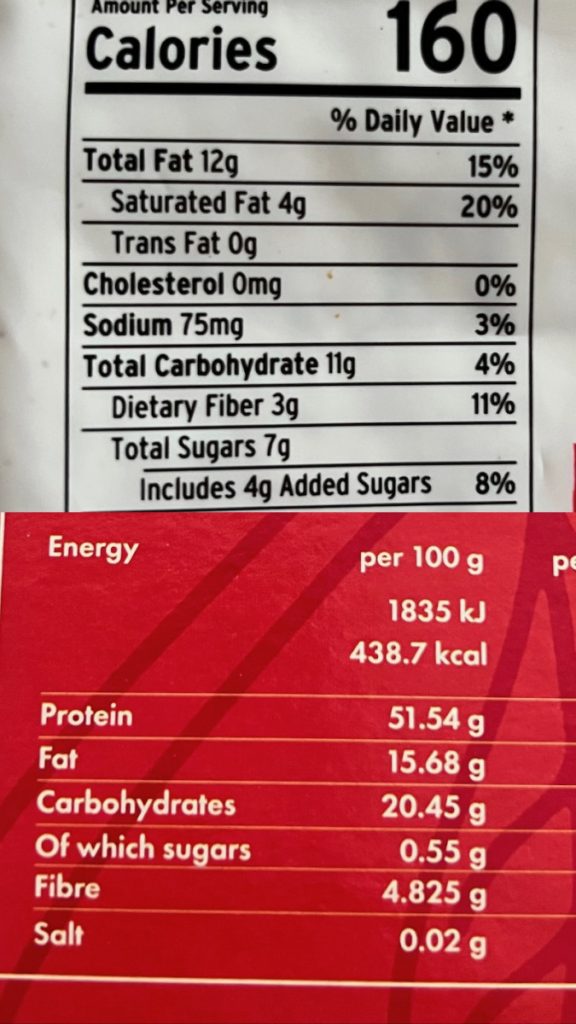Navigate to where you want to go:
You can track the carbs in 2 ways: total and net carbs. Total carbs is the total amount of carbs consumed in a day. Simply as that. Net carbs are the grams of the total carbohydrates minus the grams of total fiber and sugar alcohols.
In general, we can subtract half of the sugar alcohols (except Erythritol: its carbs can be subtracted totally from the total carbs).
Why deduct these elements? The science behind this is that fiber and sugar alcohols cannot be digested by our body, so they don’t affect the insulin response, therefore they are not counting as real carbohydrates.
So for example, let’s take 100 grams of asparagus:
Total carbs: 5,2
Fiber: 2,8
With a simple subtraction, we have that the net carbs are 2,4 per 100 grams.
Notice: Not all the experts agree on this point believing that a part of these elements can still be assimilated by our body.
Total carbs and Net carbs in the nutritional label: Europe vs. USA
Nowadays we can easily buy products from all over the world. This makes the carb calculation harder because Europe and the USA have different systems to label their products.
In the USA and Canada, the food labels are reporting the carbs including the fiber.
In these labels you can notice the fiber has an indentation – because they are part of the total carbs.
To calculate the net carbs in this case you just subtract the fibers from the total carbs.
In Europe and Australia, the nutrition labels are reporting the carbs already despoiled from the fiber.
If you notice, there is no indentation.
Check the example behind and you will immediately understand.
The first label (in white) it’s American. The total carbs are 11 gr. You can easily see from the indentation that the fibers are part of these 11 grams. The fiber was not subtracted from the total, and in this case, the net carbs are 8 gr.
The second label (in red) is European. No indentation for the fiber, fiber has its own main line. In this case, fiber has been separated from the carbs. In this case, the total carbs are 25,25 gr (carbs + fiber), and the net carbs are 20,45.

For months I followed the American system and I was eating more carbs than I wanted to. Sometimes, the fibers are higher than the carbs so it’s easy to spot that the carbs are indeed net carbs already.
Pros of counting net carbs
- More variety in the food
- You can have bigger portions of products, such as berries and nuts
- You will eat more food high in fiber
Cons of counting net carbs
- The risk of introducing more calories
- The risk of introducing more carbs than fats
- Risk of eating the wrong products because the labels can be misleading
Should I count net carbs or total carbs in the keto diet?
Counting net or total carbs in the keto diet is up to you.
I believe every one of us must have the freedom to choose which option is the best according to our body’s needs, goals, conditions, and lifestyle.
If you are starting to eat keto, I suggest a soft start. In the first 7-10 days, count the net carbs, to allow your body to adjust gradually to the new nutrition. This will prevent also the keto flu.
As always, choose a method, stick to it, and track it for some time to see what is working for you.
My experience with Net and Total carbs:
At the beginning of my keto journey, I wasn’t aware of these 2 ways of counting carbs. Then I did some research about it and I’ve decided to start counting the net carbs.
I can have more variety in my daily nutrition and this keeps me on track and focused on the low-carb life. I can have keto pizza and other keto treats when I feel it. In order to not go overboard, I track my food to make sure I am not introducing a crazy amount of carbs and calories.
Read also why and how I track my macros.

Hi, I’m Simona! After experiencing the restrictions of keto, I’m now enjoying a balanced diet that brings freedom and happiness to my eating habits.
You find me on Instagram, Pinterest, and sometimes on Facebook.
I also write a lot of keto recipes on my Italian blog keto-with-simona.
Check also:
“This post may contain affiliate links. This means I will get a commission if you purchase through my links, at no extra cost to you. All the opinions are my own. Read the full disclosure here.“















